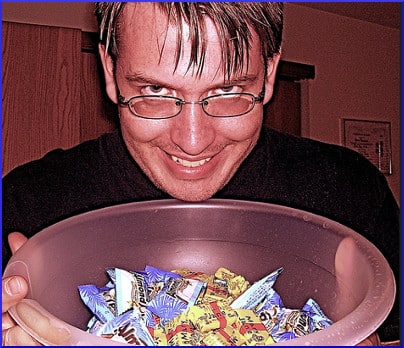
What? We’re talking about Halloween and it’s only October 1st? Exactly! The manufacturers and retailers are ready, no doubt about that, with those industrial-size packages of candy already on display. Parents need to be ready too.
Here is an interesting research topic for an ambitious student: How many grownups stock up early on trick-or-treat candy, then eat it all, and have to replace it as the scary day approaches? Of course, self-reporting makes unreliable research results. If only there were a way to discover the truth about that esoteric question!
Speaking of truth, do we even know what’s in the little calorie bombs? Sheryl Ryan for the Green Mom Guide looked up some candy ingredients and found that the goodies we and our kids eat for fun often contain trace amounts of such carcinogens as mercury, lead, and arsenic. Junk food is replete with artificial sweeteners, preservatives, flavors, and colors, many of which have been linked not only to cancer, but to Attention Deficit Hyperactivity Disorder, eczema, asthma, and allergies.
High fructose corn syrup has raised suspicions in connection with kidney and liver disease. Anyone whose alarm bells are set off by the initials GMO should know that about half of the white sugar in the United States originates from genetically modified sugar beets. If a label says “soy lecithin,” that probably comes from genetically modified plants, too. What if the package boasts of contents that are “all natural”? Ryan says:
‘Natural flavors’ can also include animal secretions, crushed insects, and other natural ingredients that many consumers — especially vegetarians and vegans — would not want to eat on their own.
Just a doggone minute! Crushed insects? Yes, says Mike Adams of Natural News:
Carmine is sourced from a mash made by grinding up beetles grown in Peru and the Canary Islands. The mash is strained out to obtain a red liquid. That liquid, made from insects, is then shipped to the United States to food companies…. That’s what’s in your yogurt (and a lot of candy and children’s foods as well). Some people have a dangerous allergic reaction to this ingredient. They can go into anaphylactic shock….
Other additives come from coal tar and petrochemicals. What is coal tar, one might ask? But a complete answer would not be forthcoming, because only about half of its components have been identified. Yellow #2 food dye has been linked with “nervous system malfunctions that ultimately are misdiagnosed as ADHD, learning disabilities, or violent behavior.” Feed a child some of that, along with a ration of sugar, and the inmates take over the asylum.
Are humans so stupid? Absolutely not. We don’t lack brains, but often our intelligent thought processes are overruled by instincts our species has possessed for millennia. Back in the days of the hunter-gatherers, bright color was usually the tipoff that a growing thing held nutritional value. Bright color was nature’s way of signifying usable energy.
One more discouraging word. Rather than buy candy, a parent might think to make cupcakes instead — something with the calories not so concentrated, but spread out and distributed among the larger bulk. But commercial frosting, it turns out, generally contains hydrogenated soybean oil, which appears to be a nerve toxin. We won’t go into it today, but many nutritionists are against soybeans in any form, including oil, whether hydrogenated, partially so, or not at all.
Stay tuned for more Halloween lore and helpful hints.
Your responses and feedback are welcome!
Source: “Don’t Let Halloween Candy Scare You,” GreenMomGuide.com, undated
Source: “How food companies fool consumers with food coloring ingredients made from petrochemicals,” NaturalNews.com, 03/21/08
Image by Matthew Frederickson

 FAQs and Media Requests:
FAQs and Media Requests: 











